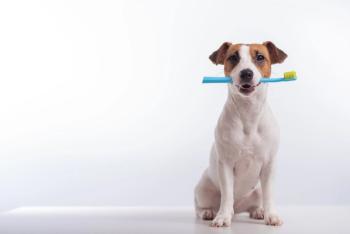
All puckered up?
I wouldn't try some of these techniques around squeamish clients.
I grew up watching my grandmother quilt. She sewed every evening. I would watch and think how cool it looked for her to slip that needle through the cloth with the aid of a thimble or two. She would tell me that I needed to be practicing on the cloth so I would be ready for the skin when I became a veterinarian. So, I would help her put a "blind hem" stitch in the patterns of the quilt. I did it for hours in the evenings as I grew up. She made it look so easy; all the pieces were pre-cut and fit together so well. I figured that the only difference would be that sewing is on cloth, and suturing is on tissue, but I was on track for an education.
Soon after becoming an animal surgeon, I realized that tissue seldom goes together as nicely as pre-cut patterns. If you are doing an elective surgery, such as a spay or neuter, then sure, the skin edges go back together just like the patterns on those quilts. But if you are repairing a horse that ran through a fence or the leftovers of a dog fight, then typically the parts just don't fit.
To get an idea of what I mean, cut a circle in a paper towel and see if you can sew the thing back together; or better yet, try attaching a garden hose to an inner-tube.
The end result of suturing things back together that don't fit is a pucker. Over the years, I have faced them countless times. When one side is longer than the other, a pucker results as you approach the end of the cut. The question is: What do you do with a pucker?
It is just sticking out there begging for some attention. Most of the time, the owner is standing there, peering over my shoulder with that look on their face that expresses a complete lack of confidence. I've even had people ask me, "What in the world are you going to do with that great big pucker that is forming as you go?"
I have overcome my fear of puckers in the last year or so. We have developed a five-step approach to handling them. If there is someone in the room with you, say the next sentence aloud for full appreciation of its melody.
You can poke a pucker, tuck a pucker, pleat a pucker, dart a pucker or cut a pucker. We go through this series of remedies, and we quit when one works.
We start by poking the pucker with one of our suturing instruments. It will disappear beneath adjacent skin, and if it doesn't leave too big of a bump or come out when you shake it, then you are done.
If the bump is too big or the pucker bulges when you shake it, then you should try to tuck the pucker by putting a stitch over it to hold it underneath the surrounding skin. If it works without leaving too much of an ugly pile of skin, then you are done.
If the pucker tucking is unsuccessful, then go to the pleat technique. Simply take one big pucker and make a bunch of little puckers out of it. They're a little like pleated pants: They lay flat but have room to expand. This works well and can be quite cosmetic. If it works, then quit; you are done.
But some puckers are too stubborn even for the pleat technique. These require the assistance of scissors. The pucker should be grasped with a pair of forceps while removing a neat wedge of skin. The "V" that is left in the skin then can be sutured together to form a nice neat "I". All but the most treacherous of pucker can be defeated by this "dart-a-pucker" procedure.
Frustration level might be a tad high if this procedure doesn't work, so we come to the last resort: cut-a-pucker. Grab the thing; cut it off, and walk away before your blood pressure gets any higher. I would not recommend this technique in front of squeamish clients.
Oh, I forgot to mention what is perhaps my favorite variety of a pucker. Our girls call it the plant-a-pucker; it's what Kerri and I put on their rosy cheeks every night we tuck them into bed.
Dr. Brock owns the Brock Veterinary Clinic in Lamesa, Texas.
Newsletter
From exam room tips to practice management insights, get trusted veterinary news delivered straight to your inbox—subscribe to dvm360.




